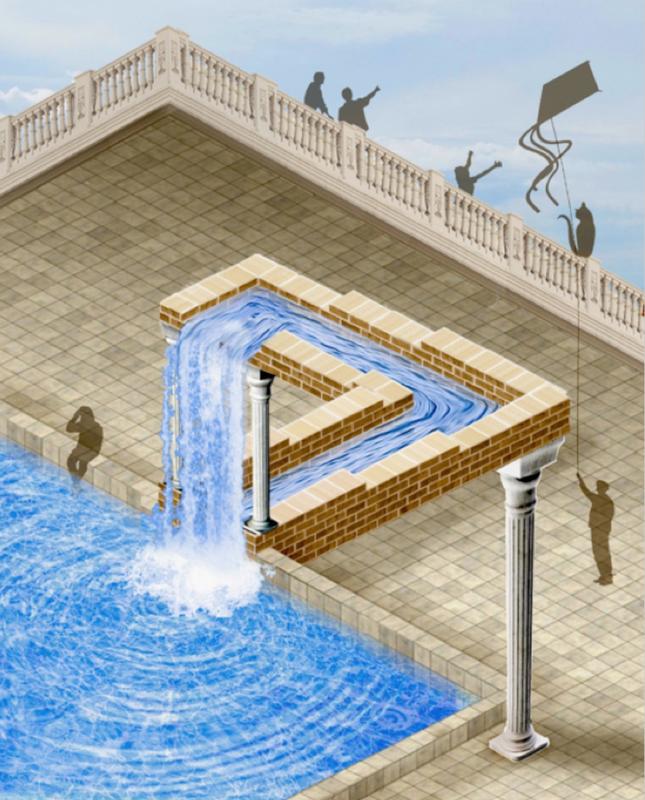
Controlling Thermal and Particle Currents with Quantum Insights

Artistic illustration of the role of a quantum observer in a nanodevice
© K. Aranburu
Measurement plays a fundamental role in quantum mechanics. At the same time, it also constitutes one of the main problems regarding the interpretation of this whole field. The best-known illustration of the principles of superposition and entanglement is Schrödinger’s cat. Not being visible from the outside, the cat resides in a coherent superposition of two states: it is alive and dead at the same time.
By means of a measurement, this superposition collapses to a concrete state: the cat is now either dead or alive. In this famous thought experiment a measurement of the “quantum cat” can be seen as an interaction with a macroscopic object collapsing the superposition onto a concrete state by destroying its coherence.
In their new article published in Nature PJ Quantum Materials, researchers from the MPSD (Max Planck Institute for the Structure and Dynamics of Matter) at CFEL (Center for Free-Electron Laser Science) in Hamburg together with collaborators from the University of the Basque Country (UPV/EHU) in San Sebastian and the Bremen Center for Computational Materials Science (BCCMS) discovered how a microscopic quantum observer is able to control thermal and electrical currents in nanoscale devices. Local quantum observation of a system can induce continuous and dynamic changes in its quantum coherence, which allows better control of particle and energy currents in nanoscale systems.
Classical non-equilibrium thermodynamics was developed to understand the flow of particles and energy between multiple heat and particle reservoirs. The best-known example is Clausius’ formulation of the second law of thermodynamics stating that when two objects with different temperatures are brought in contact, heat will exclusively flow from the hotter to the colder one.
In macroscopic objects, the observation of this process does not influence the flow of energy and particles between them. However, in quantum devices, thermodynamical concepts need to be revisited. When a classical observer measures a quantum system, this interaction destroys most of the coherence inside the system and alters its dynamical response.
Instead, if a quantum observer acts only locally, the system quantum coherence changes continuously and dynamically, thus providing another level of control of its properties. Depending on how strong and where these local quantum observations are performed, novel and surprising quantum transport phenomena arise.
The group of Prof.Dr. Angel Rubio at the Theory Department of the MPSD along with their colleagues have demonstrated how the concept of quantum measurements can offer novel possibilities for a thermodynamical control of quantum transport (heat and particle). This concept offers possibilities far beyond the ones obtained using standard classical thermal reservoirs.
The scientists studied this idea in a theoretical quantum ratchet. Within this system, the left and right side are connected to hot and cold thermal baths, respectively. This configuration forces the energy to flow from hot to cold and the particles to flow clockwise inside the ratchet. The introduction of a quantum observer, however, inverts the particle ring-current against the natural direction of the ratchet – a phenomenon caused by the localized electronic state and the disruption of the system’s symmetry.
Furthermore, the quantum observation is also able to invert the direction of the heat flow, contradicting the second law of thermodynamics. “Such heat and particle current control might open the door for different strategies to design quantum transport devices with directionality control of the injection of currents. There could be applications in thermoelectricity, spintronics, photonics, and sensing, among others. These results have been an important contribution to my PhD thesis.” says Robert Biele, first author of the paper.
From a more fundamental point of view this work highlights the role of a quantum observer: In contrast to Schrödinger’s cat, where the coherent state is destroyed via the interaction with a macroscopic “observer”, here by introducing a local quantum observer, the coherence is changed locally and dynamically, allowing to tune between the coherent states of the system. “This shows how thermodynamics is very different in the quantum regime. Schrödinger’s cat paradox leads to new thermodynamic forces never seen before,” adds César A. Rodríguez Rosario.
In the near future, the researchers will apply this concept to control spins for applications in spin injection and novel magnetic memories. Angel Rubio suggests that “The quantum observer – besides controlling the particle and energy transfer at the nanoscale – could also observe spins, select individual components, and give rise to spin-polarized currents without spin-orbit coupling. Observation could be used to write a magnetic memory.”
This work was carried out in a collaboration of the Max Planck Institute for the Structure and Dynamics of Matter (MPSD) in Hamburg with the NanoBio Spectroscopy Group at the University of the Basque Country in San Sebastian (UPV/EHU) and the Bremen Center for Computational Materials Science (BCCMS). It was funded by the European Research Council Advanced Grant “Qspec-Newmat”, Grupos Consolidados del Gobierno Vasco and the Marie Skłodowska-Curie Actions – Individual Fellowships.
Contacts: Dr. César Alberto Rodriguez Rosario, Postdoc, Telephone: +49 (0)40 8998-6643 cesar-a.rodriguez-rosario@mpsd.mpg.de
Prof. Dr. Angel Rubio, Managing Director MPSD: Telephone: +49 (0)40 8998-6550 angel.rubio@mpsd.mpg.de
Full picture caption: “Artistic illustration of the role of a quantum observer in a nanodevice: When observing only the right part of the figure (covering the left part with the hand the water appears to flow down the channel, instead, by looking at the whole painting the water actually flows uphill. This apparent paradox mimics the coherent superposition of two quantum states (water flowing up and down). By observing at specific parts of our system we are able to tune between these two states and hence change the ‘physical response of the nanodevice’ in a controlled way.”
https://www.nature.com/articles/s41535-017-0043-6 (original publication)
http://www.mpsd.mpg.de/419754/2017-07-THERMOELECTRICS_Observe_control (MPSD-web site)












